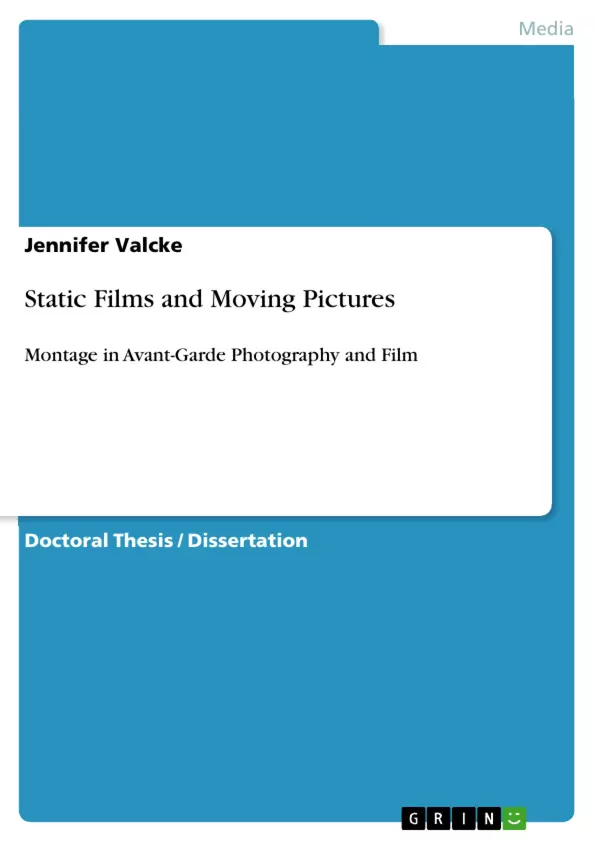Photomontage has more to do with film than with any other art form - they have in common the technique of montage. (Sergei Tretyakov)
By considering that photomontage and film use the technique of cutting and gluing as dominant artistic device, and that montage, a technique unifying art and technology for the first time, emerged as a dominant artistic feature of the avant-garde, this thesis will explore the ideological and perceptual implications of its advent in avant-garde art and film. The technological advances of the beginning of the twentieth century, and particularly the advent of photography, allowed avant-garde artists to break free from traditional concepts of artistic production – they dispensed with the old criteria of uniqueness, originality, handicraft and personal style. At a time when many avant-garde artists abruptly ceased to paint, photomontage emerged as the privileged locus for a caesura with traditional art forms. Photomontage envisioned film aesthetics insofar as it combines and juxtaposes images of various perspectival planes and angles (Raoul Hausmann described his early photomontages as “motionless moving pictures”). A corresponding observation can be made on the use of montage in cinema, a technique which crucially underpins the illusion of movement created through the succession of photographic stills. The present thesis will investigate photomontage and film in order to examine the effect technological reproduction played in revolutionising artistic production, perception and ideology – where the technique and philosophy of montage was key.
Table of Contents
- Introduction: Static Films and Moving Pictures
- Chapter 1: Montage as a Tool for Modernity
- 1.1. Avant-Garde and the Rise of Montage
- 1.2. Photomontage: A Technological Shift in Artistic Production
- 1.3. Photomontage as a Challenge to Traditional Art Forms
- Chapter 2: Photomontage and Film: An Intertwined History
- 2.1. The Influence of Photomontage on Film Aesthetics
- 2.2. Film Montage and its Role in Creating the Illusion of Movement
- Chapter 3: The Ideological and Perceptual Implications of Montage
- 3.1. Montage and the Redefinition of Reality
- 3.2. Montage as a Tool for Political and Social Commentary
- Conclusion: The Lasting Legacy of Montage
Objectives and Key Themes
This thesis examines the development and influence of montage, particularly in avant-garde photography and film. It explores the technological, ideological, and perceptual implications of this artistic technique, emphasizing its role in revolutionizing artistic production and challenging traditional art forms.- The emergence of montage in avant-garde art, particularly in relation to the rise of photography and new technologies.
- The relationship between photomontage and film aesthetics, highlighting their shared use of montage techniques.
- The ideological and perceptual impact of montage, analyzing its potential to redefine reality and challenge traditional artistic norms.
- The significance of montage as a tool for social and political commentary.
- The lasting legacy of montage in art and film.
Chapter Summaries
- Chapter 1 introduces the concept of montage as a tool for modernity, exploring its origins in the avant-garde movement. This chapter examines the technological shift in artistic production brought about by photography and the emergence of photomontage as a challenge to traditional art forms.
- Chapter 2 delves into the intertwined history of photomontage and film. It analyzes the influence of photomontage on film aesthetics, highlighting the use of montage techniques in creating the illusion of movement in cinema.
- Chapter 3 explores the ideological and perceptual implications of montage. This chapter examines how montage can redefine reality and challenge traditional artistic norms, as well as its potential as a tool for social and political commentary.
Keywords
The thesis focuses on the key concepts of photomontage, film montage, avant-garde art, technological innovation, artistic production, perception, ideology, social and political commentary, and the lasting legacy of montage.- Citar trabajo
- Jennifer Valcke (Autor), 2008, Static Films and Moving Pictures, Múnich, GRIN Verlag, https://www.grin.com/document/181024



